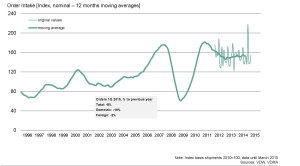
During the first quarter of 2015, order bookings for the German machine tool industry were down by 8 per cent compared to the first quarter of 2014. Domestic orders fell by 19 per cent, while orders from abroad shrank by 2 per cent. “Compared to a strong first quarter in 2014, demand for machine tools is currently taking a breather,” commented Dr. Wilfried Schäfer, Executive Director of the sectoral organisation VDW (German Machine Tool Builders’ Association) in Frankfurt am Main. The fall in demand, he said, results primarily from the significant downturn in domestic orders, crucially reflecting the high base effect of last year’s strong equivalent period. Compared to the first two months of 2015, however, March reveals a perceptibly better picture. “The German economy is trending upwards, as the latest IFO Business Climate Index makes clear. Due to the weak euro and the low raw material prices, we anticipate that domestic demand from our high-export-ratio customer sectors, too, will gather momentum in the months ahead,” said Wilfried Schäfer.
In March, orders from abroad achieved turnaround, rising by 6 per cent, whereas in January and February the figures were still in the minus range. It is primarily the orders from the Eurozone that underpinned demand for machine tools in the first quarter of 2015, with a plus of 26 per cent. The continuous growth in orders since the autumn of last year confirms that European customers are more optimistic, and that the investment backlog in the Eurozone has been overcome. This is also reflected in the Purchasing Manager Index, which has most recently picked up again in the industrial sector.
The explanation for the overall drop in orders from abroad during the year’s first quarter is that demand from Asia, in particular, was tentative. But the recently held CIMT in Beijing, China’s premier trade fair for machine tools, provides grounds for optimism. The Chinese government’s declared goal is a quality thrust in the industrial sector, for concomitantly enhanced competitiveness on the global market. One of the key factors for the requisite modernisation and diversification of China’s industrial sector is state-of-the-art production technology. “For this technological transformation, China is increasingly prioritising quality before quantity. This trend will also benefit the German machine tool manufacturers with their high-tech products. This can be substantiated not least by noting that since the second half of 2014 orders from China are again starting to show a significant increase,” explained the VDW’s Executive Director. But Wilfried Schäfer also sees abundant potential in the USA as the second-most-important market: “Following a strong preceding year, it’s above all the favourable euro-to-dollar exchange rate that in the months ahead can be expected to boost business with the USA.”




